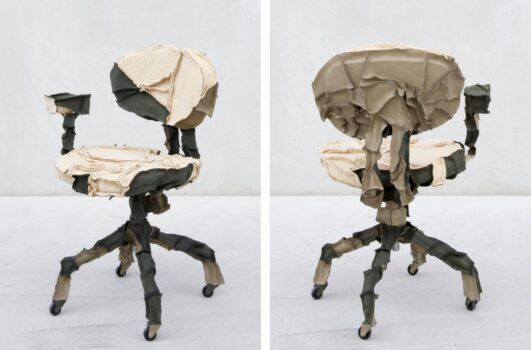In Kent Monkman’s 2017 painting Helping the Helpless, a naked, blond-haired guy writhes in the dirt, while a muscular Indigenous Canadian man, likewise wearing his birthday suit, stretches down to pick the defenseless fellow up from his ribcage.
Painted in Monkman’s magical realist manner, the work is simultaneously mythical, personal and political, and, unlike many of his other creations, it is imbued with a quiet simplicity.
“Monkman throughout his career is considering, referencing or subverting Old Master painters,” says Troy Seidman, founder of Caviar20 gallery, in Toronto. “Here, he is clearly interacting with Caravaggio.”
But the message of the piece is harder to decipher. “What makes this painting so intriguing is that the action is so ambiguous,” Seidman adds. “Why is this Indigenous man gently embracing or trying to lift this nude blond-haired man? Is this a gesture of helpfulness, as the title suggests, or is there something possessive, sexual or even violent occurring?”

The painting is one of the earliest in Monkman’s ongoing series “The Rendezvous,” which looks back on a period in the early 19th century when Indigenous people and Western settlers would gather in the wilderness to celebrate the arrival of spring.
These revelries — real, historical occurrences — offered periods of relative freedom, removed from the uptight norms of colonial settlements. Monkman reimagines this short-lived tradition as an anarchic queer Paradise, where fluidity of gender, sexuality and cultures flourished before the advance of European assimilation and religious dogmatism.
The landscape of Helping the Helpless is sparse, with only a few plants sprouting from the earth, placing the figures in the liminal space of spring thaw and cultural collision.
Monkman, born in 1965 and of Cree and Irish heritage, is one of Canada’s most celebrated and controversial artists. His practice spans painting, performance, installation and video, often featuring his alter ego, Miss Chief Eagle Testickle. This time-traveling, two-spirit provocateur in high heels re-creates colonial narratives with a theatrical blend of grace, camp and fury.
In Helping the Helpless, Miss Chief is notably absent. So is raucous satire. What’s there instead is something more subtle and intimate: a moment of contact whose meaning is just out of reach.
“The brilliance of Kent Monkman’s work is that he’s often revisioning the interactions between early settlers in Canada and its Indigenous peoples,” Seidman explains. “At times, he reveals the brutality. In other images, he imagines sexual playfulness and art-historical fantasy.”
And, as Seidman shares, Monkman is obsessive about the historical and botanical accuracy of his scenes. His studio reportedly even went so far as to cultivate native Canadian varieties of tobacco plants to serve as references.
Monkman’s evolution as a painter can be seen in the scale and prominence of his characters within their environs. “In his earlier paintings, circa 2008 to 2012, the figures or narrative action were quite small amid majestic landscapes,” Seidman says. “But by 2017 or ’18, just before Monkman debuted his epic two-painting installation at the Metropolitan Museum of Art, in New York, the figures had become life-size or larger.” Helping the Helpless clearly falls into the latter category.
The painting’s one and only owner to date is a prominent Canadian philanthropist who purchased the canvas directly from the artist shortly after its completion. It is being offered on Caviar20’s 1stDibs storefront just as Monkman’s career is skyrocketing.

The artist currently has a solo show at the Denver Art Museum, “Kent Monkman: History is Painted by the Victors,” comprising 41 grand-scale works, many of which riff on historical paintings ranging in style from Italian Renaissance to American Regionalism. On view until August 17, the exhibition, along with the Met commission, could cement his place in the contemporary-art canon internationally.
“Monkman is an exceptional figurative painter with a distinctive and alluring aesthetic,” Seidman says. “His work is a delicious pastiche of Old Master paintings, comic books, Canadian Indigenous history. He is in a league of his own.”







